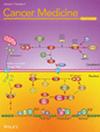Multi-Institutional MR-Derived Radiomics to Predict Post-Exenteration Disease Recurrence in Patients With T4 Rectal Cancer
Abstract
Introduction
Local recurrence and distant metastasis remain a concern in advanced rectal cancer, with up to 10% and 20%–30% of patients suffering local and distal progression, respectively. Radiomics refers to a novel technology that extracts and analyses quantitative imaging features from images, which can be subsequently used to develop and test clinical models predictive of outcomes. We aim to develop and test an MRI-based radiomics nomogram predictive of disease recurrence in patients with T4 rectal cancer.
Methods
We conducted a multi-institutional retrospective analysis of 55 patients with T4 rectal cancer treated with neoadjuvant chemoradiotherapy followed by exenterative surgery. Radiomic features were extracted from pre-treatment T2-weighted MRI scans and used to construct predictive models. The top-performing radiomic signatures were identified, and internal validation with 1000 bootstrap samples was performed to calculate optimism-corrected performance measures.
Results
Two radiomic signatures were identified as strong predictors of post-operative disease recurrence. The best-performing model achieved an optimism-corrected AUC of 0.75, demonstrating good discriminative ability. Calibration plots showed a satisfactory fit of the predictions to the actual rates, and decision curve analyses confirmed the positive net benefit of the models.
Conclusion
The MRI-based radiomics nomogram provides a promising tool for predicting disease recurrence in T4 rectal cancer patients post-exenteration. This model could improve risk stratification and guide more personalized treatment strategies. Further studies with larger cohorts and external validation are needed to confirm these findings and enhance the model's generalizability.


 求助内容:
求助内容: 应助结果提醒方式:
应助结果提醒方式:


